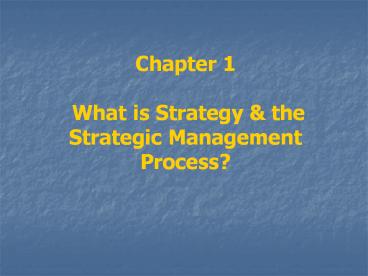Chapter 1 What is Strategy PowerPoint PPT Presentation
1 / 24
Title: Chapter 1 What is Strategy
1
Chapter 1 What is Strategy the Strategic
Management Process?
2
Key Chapter Objectives
- Have an understanding of
- what is strategic management.
- the strategic management process.
- what competitive advantage is
- why stakeholders are important.
- key environmental forces that are creating
dynamic fast-paced change. - the need for a hierarchy of goals
3
What is Strategic Management?
- The analysis, decisions, and actions an
organization undertakes in order to create and
sustain competitive advantages (Dess Lumpkin,
2003 p.3). - A pattern in a stream of actions or decisions
(Henry Mintzberg).
4
Types of Strategies
- Strategy as a Plan
- Strategy as a Ploy
- Strategy as a Pattern
- Strategy as a Perspective
- Strategy as a Position
5
Key Attributes of Strategy
- Directs organization toward overall goals
objectives. - Includes multiple stakeholders in decision
making. - Must incorporate short- long-term perspectives.
- Recognizes trade-offs between efficiency
effectiveness.
6
Challenges of Strategic Managers
Short-term Goals Long-term Goals
Profitability
Key Stakeholders
Network
Changing Landscape
Long-Term Planning
Quarterly Performance
Develop Cohesive Organization
Diverse Workforce
7
Overall View of the Strategic Management Process
Analysis
Decisions
Actions
8
Strategic Management Process
9
Strategic Management Process
External Analysis
Strategic Choice
Strategy Implementation
Competitive Advantage
Objectives
Internal Analysis
Mission
Barney Hesterly p. 5
10
Analysis Mission Objectives
- Vision statements are an inspiring, overarching,
and long-term statement. - Mission statements encompasses both the purpose
of the company and the basis of competition and
competitive advantage. - Objectives are developed from the vision and
mission statements.
11
Analysis External Internal
- Analysis of the Firms External Environment
- What are the trends in the industry?
- What are the trends in the general environment?
- What are the competitors trends?
- Analysis of the Firms Internal Environment
- What are the firms resources?
- What are the firms capabilities?
- What are the firms distinctive competencies?
12
Decisions (Strategic Choice)
- Strategy Formulation
- Functional-level (HR, Manufacturing, Marketing,
etc.) - Business-level (Cost, differentiation, focus, or
integrative) - Corporate-level (diversification, restructuring)
13
Actions(Strategy Implementation)
- Strategy Implementation through
- Organizational Structure.
- Control Systems.
- Leadership.
- Response to Change.
14
Competitive Advantage
- Definition the ability to create more economic
value than competitors
15
Competitive Parity
- The firms offerings are average
- People do not have a preference for the
- firms offering
- The firm does not have a cost advantage
- over others
- Some things that may lead to competitive
- parity may still be critical to success
- (e.g., telephones)
16
Competitive Disadvantage
- People may have an aversion to the firms
offering. - A firm may have outdated technology/ equipment.
- The firm may have a cost disadvantage.
- A firm may have a negative reputation.
17
Competitive Advantage
- Two Types of Difference
- Preference for the firms output
- people choose the firms output over others
- people are willing to pay a premium
- Cost advantage vis-à-vis competitors
- lower costs of production/distribution
18
Competitive Advantage
- Competitive advantage is often temporary
- Competitive advantage typically results in high
profits. - Profits attract competition.
- Competition limits the duration of competitive
advantage in most cases.
19
Competitive Advantage
- However, may be sustainable if
- Competitors are unable to imitate the source of
advantage - No one conceives of a better offering.
20
Measuring Competitive Advantage
- Two Classes of Measures
- Accounting Measures
- ROA, ROS, ROE, etc. that exceed industry
averages. - Economic Measures
- earning a return in excess of the cost of capital
21
Emergent vs. Intended Strategies
- The strategic management process leads managers
to intended strategies. - However,
- Conditions often change or new information
becomes available. - Managers respond and adopt emergent strategies.
22
Stakeholders
- Stakeholders are individuals or groups inside or
outside the company, that has a stake in and can
influence an organizations performance. - Five primary stakeholder groups
- Customers, 4. the Community
- Employees, 5. Owners
- Suppliers
23
Strategic Management Process
- Summary
- This course is not about mere survival, it is
about thrivingachieving competitive advantage. - the strategic management process helps managers
achieve competitive advantage. - competitive advantage depends on differences.
- strategy is about discovering and exploiting
these differences.
24
Strategic Management Process
- Applying Strategy to Your Career
- a solid understanding of strategy concepts will
help set you apart from other job candidates. - you can use the process to identify and exploit
difference between you and others. - you can use the process to determine if you want
to stay with a company.

